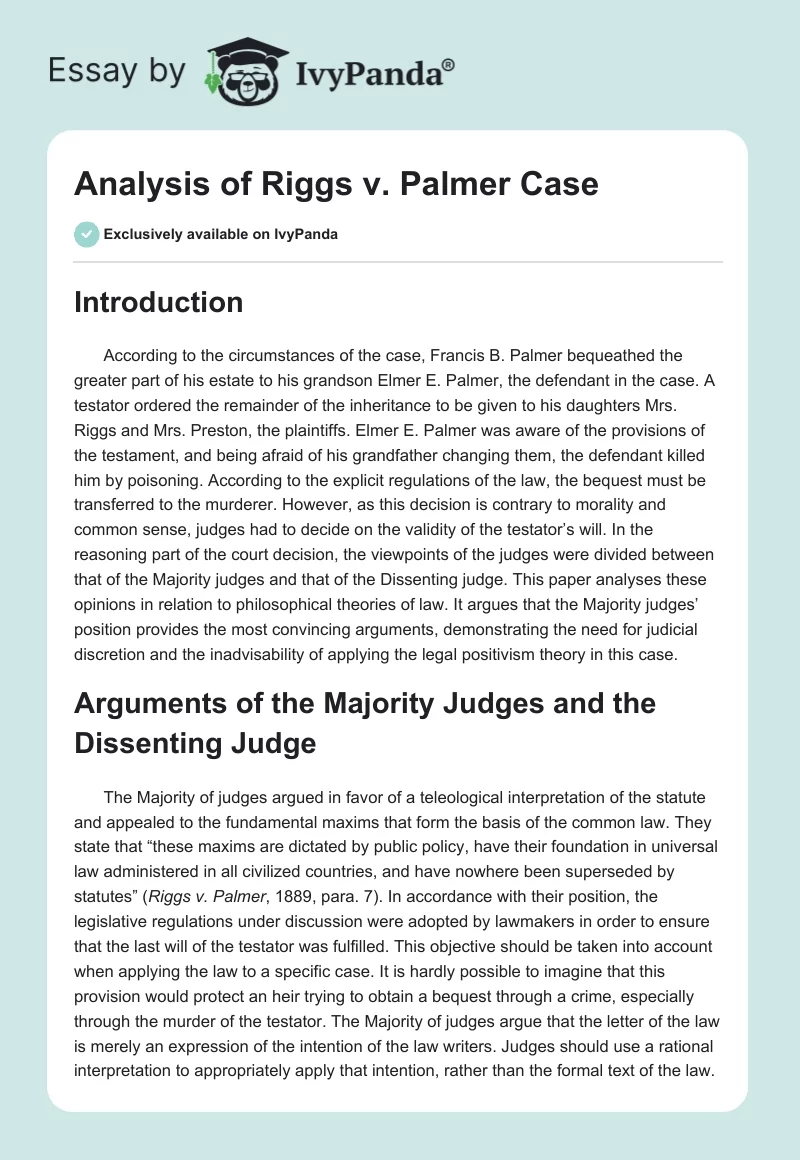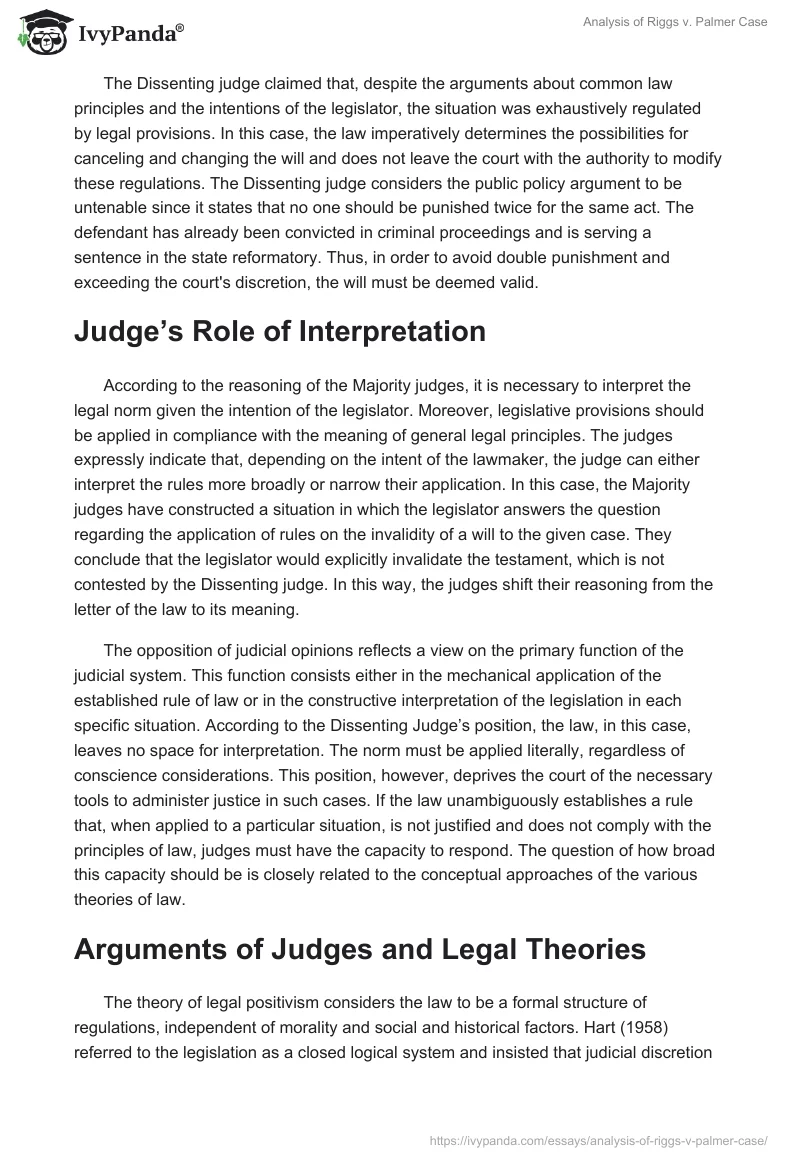Introduction
According to the circumstances of the case, Francis B. Palmer bequeathed the greater part of his estate to his grandson Elmer E. Palmer, the defendant in the case. A testator ordered the remainder of the inheritance to be given to his daughters Mrs. Riggs and Mrs. Preston, the plaintiffs. Elmer E. Palmer was aware of the provisions of the testament, and being afraid of his grandfather changing them, the defendant killed him by poisoning. According to the explicit regulations of the law, the bequest must be transferred to the murderer.
However, as this decision is contrary to morality and common sense, judges had to decide on the validity of the testator’s will. In the reasoning part of the court decision, the viewpoints of the judges were divided between that of the Majority judges and that of the Dissenting judge. This paper analyses these opinions in relation to philosophical theories of law. It argues that the Majority judges’ position provides the most convincing arguments, demonstrating the need for judicial discretion and the inadvisability of applying the legal positivism theory in this case.
Arguments of the Majority Judges and the Dissenting Judge
The Majority of judges argued in favor of a teleological interpretation of the statute and appealed to the fundamental maxims that form the basis of the common law. They state that “these maxims are dictated by public policy, have their foundation in universal law administered in all civilized countries, and have nowhere been superseded by statutes” (Riggs v. Palmer, 1889, para. 7).
In accordance with their position, the legislative regulations under discussion were adopted by lawmakers in order to ensure that the last will of the testator was fulfilled. This objective should be taken into account when applying the law to a specific case. It is hardly possible to imagine that this provision would protect an heir trying to obtain a bequest through a crime, especially through the murder of the testator. The Majority of judges argue that the letter of the law is merely an expression of the intention of the law writers. Judges should use a rational interpretation to appropriately apply that intention, rather than the formal text of the law.
The Dissenting judge claimed that, despite the arguments about common law principles and the intentions of the legislator, the situation was exhaustively regulated by legal provisions. In this case, the law imperatively determines the possibilities for canceling and changing the will and does not leave the court with the authority to modify these regulations. The Dissenting judge considers the public policy argument to be untenable since it states that no one should be punished twice for the same act. The defendant has already been convicted in criminal proceedings and is serving a sentence in the state reformatory. Thus, in order to avoid double punishment and exceeding the court’s discretion, the will must be deemed valid.
Judge’s Role of Interpretation
According to the reasoning of the Majority judges, it is necessary to interpret the legal norm given the intention of the legislator. Moreover, legislative provisions should be applied in compliance with the meaning of general legal principles. The judges expressly indicate that, depending on the intent of the lawmaker, the judge can either interpret the rules more broadly or narrow their application.
In this case, the Majority judges have constructed a situation in which the legislator answers the question regarding the application of rules on the invalidity of a will to the given case. They conclude that the legislator would explicitly invalidate the testament, which is not contested by the Dissenting judge. In this way, the judges shift their reasoning from the letter of the law to its meaning.
The opposition of judicial opinions reflects a view on the primary function of the judicial system. This function consists either in the mechanical application of the established rule of law or in the constructive interpretation of the legislation in each specific situation. According to the Dissenting Judge’s position, the law, in this case, leaves no space for interpretation.
The norm must be applied literally, regardless of conscience considerations. This position, however, deprives the court of the necessary tools to administer justice in such cases. If the law unambiguously establishes a rule that, when applied to a particular situation, is not justified and does not comply with the principles of law, judges must have the capacity to respond. The question of how broad this capacity should be is closely related to the conceptual approaches of the various theories of law.
Arguments of Judges and Legal Theories
The theory of legal positivism considers the law to be a formal structure of regulations, independent of morality and social and historical factors. Hart (1958) referred to the legislation as a closed logical system and insisted that judicial discretion could only serve as extra-legal standards applied if the law did not regulate a particular situation.
It should be noted that the position of the Dissenting judge is consistent with the understanding of the law by this theory. If these provisions are to be referred to in Riggs v. Palmer case, it should be acknowledged that judges must indeed apply the law literally. In this sense, the literal application of the law is regarded as an intrinsic value.
Nevertheless, legislative provisions, being indeed a formal and logical system, have a specific purpose, which is envisaged by the legislator. Fuller (1969) describes this purpose within the framework of Natural Law Theory as the inner morality of law, that is, a set of meaningful principles on which specific regulations are based. The core point of contention is whether judges, by their interpretation, can change the scope of law guided by these internal moral principles.
The theory of Interpretivism argues that the basis of judicial action is precisely a constructive interpretation of the law, which is designed to make its application better. Dworkin (1982) distinguished law by the rules applied when appropriate and the principles which are the source of the motives for the court decision. Interpretation is, therefore, considered the only relevant technique for applying the principles.
The position of the Majority judges is consistent with both of these theories. The appeal to the fundamental maxims of common law and public policy reflects the application of the inner morality of the law. The arguments for the freedom of judicial interpretation are in line with the reasoning of Interpretivism.
Judges, in this case, are guided by the intention of the legislator, which hardly covers the legality of the inheritance to the murderer of the testator. This position provides an answer to the question of the primary function of the court, which is to apply the law in an interpretative manner consistent with its principles. The opposing judge’s argument of double punishment is ineffective since the invalidity of the will is not a special punishment for the defendant. It is just an application of the law as interpreted by the court to a specific civil action.
Conclusion
Thus, it should be noted that the position of the Majority judges is more reasonable because it takes into account the fundamental meaning of the law and the intention of the legislator. The literal application of the law is not a value in itself. Judicial discretion and interpretation of legislation are the instruments of the court that ensure the fair and appropriate application of state regulation.
References
Dworkin, R. (1982). Law as interpretation. Critical Inquiry, 9(1), 179–200.
Fuller, L. L. (1969). The morality of law. New Haven, CT: Yale University Press.
Hart, H. L. A. (1958). Positivism and the separation of law and morals. Harvard Law Review, 71(4), 618-619.
Riggs v. Palmer, 115 NY 506 (1889).


